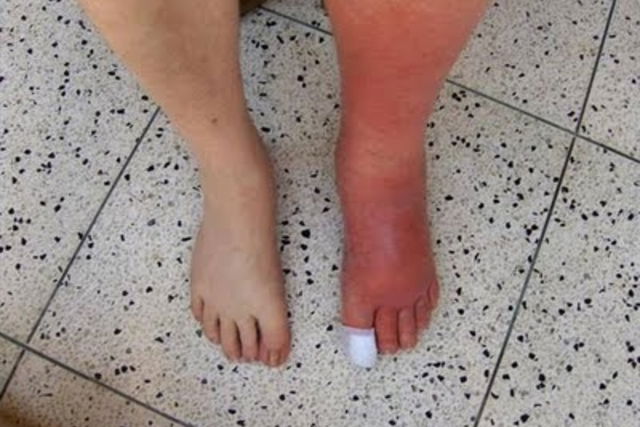Cellulitis occurs when bacteria penetrates the skin and infects its deepest layers. It causes symptoms like skin redness, pain and swelling, and is most commonly seen in the lower extremities.
Contrary to cellulite, cellulitis can lead to serious complications like septicemia, which is a systemic infection in the whole body, or even death if left untreated.
If you suspect you may have a skin infection, you should proceed to the emergency room for diagnosis and treatment, which usually involves the use of antibiotics.

Main symptoms
Some symptoms that can appear with cellulitis are:
- Pain in the affected area
- Red patches on the skin with an undefined border
- Extensive red areas throughout the body
- Fever over 38ºC (100.4ºF)
- Skin that is swollen and may exude pus
- Swollen lymph nodes near the affected area
In more serious cases, symptoms may also include tremors, chills, fatigue, dizziness, excessive sweating and muscular pain. Symptoms like drowsiness, blisters or welts on the skin may be a sign that the infectious is worsening.
All of these symptoms may be a sign of another type of skin infection, like erysipelas, which is an illness affects the most superficial layers of the skin. Therefore, you should see a doctor if you have symptoms, so that the right diagnosis and treatment can be started.
Also recommended: Red Spots On Skin: Top 19 Causes (with Pictures & Treatment) tuasaude.com/en/red-spots-on-skinConfirming a diagnosis
In most cases, cellulitis is diagnosed by a dermatologist through assessment of the patients’s signs and symptoms. However, because the symptoms can present very similarly to other diseases (like erysipelas), the doctor may order bloodwork or lab specimen testing of the skin to confirm the type of bacteria causing the infections.
Cellulitis vs erysipelas
The main difference between cellulitis and erysipelas is that depth of skin affected: erysipelas is usually found in the superficial layers of the skin, while cellulitis is found in the deepest layers. Other factors that help to differentiate these two conditions include:
The signs and symptoms of these diseases are very similar, which is why a family doctor or dermatologist should examine the affected areas and order testing. They will be able to identify the underlying cause and orient treatment as necessary.
Possible causes
Cellulitis occurs when bacteria like Staphylococcus or Streptococcus penetrate the skin. It is more commonly diagnosed in people with recent surgical incisions or with wounds that were left untreated.
People with skin problems that cause irregular skin growth, like eczema, dermatitis or a fungal infection, are also at a higher risk for developing cellulitis. Those with a weakened immune system are also at greater risk.
Is cellulitis contagious?
In healthy people, cellulitis is not contagious, as it does not easily transfer from one person to another. However, if you have a wound or skin-related illness, bacteria is at a greater risk enter in contact with the compromised skin and develop into a cellulitis.
Treatment options
Treatment for infectious cellulitis is guided by a dermatologist, infectious disease specialist or general practitioner and generally involves the use of oral antibiotics.
The doctor may prescribe antibiotics, such as cephalexin or clindamycin, for 5 to 14 days, although in some cases, hospitalization may be necessary for IV antibiotics.
The doctor may also prescribe painkillers, like acetaminophen, to reduce fever and relieve symptoms during treatment.
It is also important to assess the skin regularly, and for wound dressings to be changed at least on a daily basis. The doctor may advise antibiotic ointments with dressing changes to ensure a more thorough treatment approach.
Best antibiotic for infectious cellulitis
The best antibiotic for infectious cellulitis varies depending on the type of bacteria that is causing the infection. Clindamycin or cephalexin are those most typically recommended medications for this condition.
In some cases, the doctor may also recommend the use of sulfamethoxazole + trimethoprim in combination with cephalexin, or even IV antibiotics, such as vancomycin or cefazolin.
Recovery time
Typically, the symptoms of infectious cellulitis begin to improve about 48 hours after starting antibiotics, however, the time it takes for infectious cellulitis to fully heal varies from person to person. It can take 5 to 14 days, which is about the duration of treatment prescribed by the doctor.
During treatment for infectious cellulitis, if symptoms worsen, it may be necessary to change antibiotics or to admit the patient to the hospital for IV treatment and to spread further spreading of the infection.
